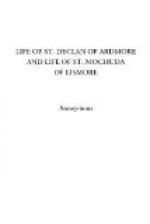By “Lives” are here meant the old Ms. biographies which have come down to us from ages before the invention of printing. Sometimes these “Lives” are styled “Acts.” Generally we have only one standard “Life” of a saint and of this there are usually several copies, scattered in various libraries and collections. Occasionally a second Life is found differing essentially from the first, but, as a rule, the different copies are only recensions of a single original. Some of the MSS. are parchment but the majority are in paper; some Lives again are merely fragments and no doubt scores if not hundreds of others have been entirely lost. Of many hundreds of our Irish saints we have only the meagre details supplied by the martyrologies, with perhaps occasional reference to them in the Lives of other saints. Again, finally, the memory of hundreds and hundreds of saints additional survives only in place names or is entirely lost.
There still survive probably over a hundred “Lives”—possibly one hundred and fifty; this, however, does not imply that therefore we have Lives of one hundred or one hundred and fifty saints, for many of the saints whose Acts survive have really two sets of the latter—one in Latin and the other in Irish; moreover, of a few of the Latin Lives and of a larger number of the Irish Lives we have two or more recensions. There are, for instance, three independent Lives of St. Mochuda and one of these is in two recensions.
The surviving Lives naturally divide themselves into two great classes—the Latin Lives and the Irish,—written in Latin and Irish respectively. We have a Latin Life only of some saints, and Irish Life only of others, and of others again we have a Latin Life and an Irish. It may be necessary to add the Acts which have been translated into Latin by Colgan or the Bollandists do not of course rank as Latin Lives. Whether the Latin Lives proper are free translations of the Irish Lives or the Irish Lives translations of Latin originals remains still, to a large extent, an open question. Plummer ("Vitae SSm. Hib.,” Introd.) seems to favour the Latin Lives as the originals. His reasoning here however leaves one rather unconvinced. This is not the place to go into the matter at length, but a new bit of evidence which makes against the theory of Latin originals may be quoted; it is furnished by the well known collection of Latin Lives known as the Codex Salmanticensis, to which are appended brief marginal notes in mixed middle Irish and Latin. One such note to the Life of St. Cuangus of Lismore (recte Liathmore) requests a prayer for him who has translated the Life out of the Irish into Latin. If one of the Lives, and this a typical or characteristic Life, be a translation, we may perhaps assume that the others, or most of them, are translations also. In any case we may assume as certain that there were original Irish materials or data from which the formal Lives (Irish or Latin) were compiled.




